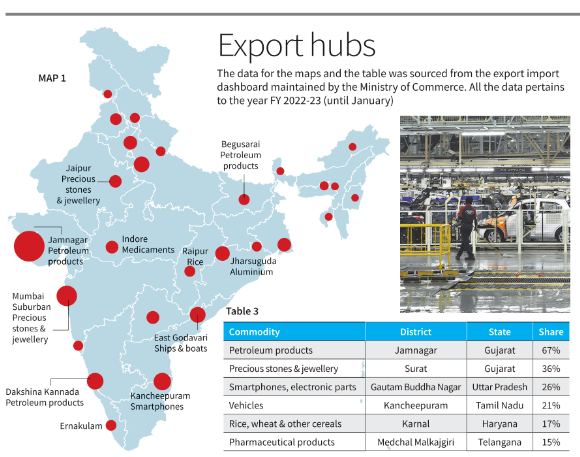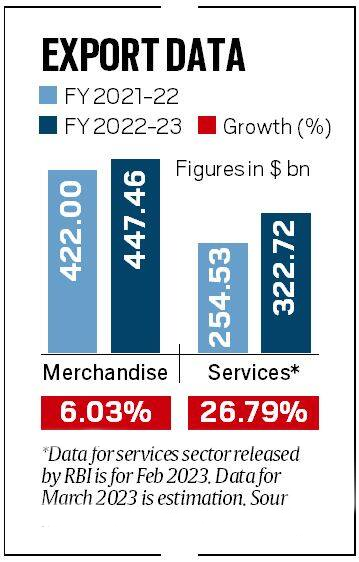Economy
India’s Export Capabilities
- 19 Apr 2023
- 7 min read
For Prelims: Top Exporting District in India, Mega Integrated Textile Region and Apparel (MITRA) Park, Russia-Ukraine War, Industry 4.0 technologies, Space, Semiconductor, Solar energy
For Mains: Status of the Export Sector in India, Challenges Related to the Export Sector.
Why in News?
Jamnagar in Gujarat is the top exporting district in India. It formed about 24% of India's exports in value terms in FY23 (till January).
- Surat in Gujarat and Mumbai Suburban in Maharashtra feature second and third by a distance, forming only about 4.5% of the country's exports in the period.
- The other districts in the top 10 are Dakshina Kannada (Karnataka), Devbhumi Dwarka, Bharuch and Kachchh (Gujarat), Mumbai (Maharashtra), Kancheepuram (Tamil Nadu) and Gautam Buddha Nagar (Uttar Pradesh).
What is the Status of the Export Sector in India?
- Status of Trade:
- The merchandise trade deficit, which is the gap between exports and imports, increased by over 39% in 2022-23 to record USD 266.78 billion, as compared to USD 191 billion in 2021-22.
- Merchandise imports increased by 16.51% in 2022-23, while merchandise exports rose by 6.03%.
- Overall trade deficit, however, stood at USD 122 billion in 2022-23, as compared to USD 83.53 billion in the 2022, gaining support from trade surplus in services.
- India’s Major Export Arenas:
- Engineering Goods: They registered a 50% growth in exports, at USD 101 bn in FY22.
- Currently, all pumps, tools, carbides, air compressors, engines, and generators manufacturing MNC companies in India are trading at all-time highs and shifting more production units to India.
- Agriculture Products: Agricultural exports were buoyed by the government's push to meet global demand for food amid the pandemic. India exports rice worth USD 9.65 bn, the highest among agricultural commodities.
- Textile and Apparels: India’s textile and apparel exports (including handicrafts) stood at USD 44.4 billion in FY22, a 41% increase on a YoY basis.
- Government’s scheme like Mega Integrated Textile Region and Apparel (MITRA) Park are giving a strong boost to this sector.
- Engineering Goods: They registered a 50% growth in exports, at USD 101 bn in FY22.
- Pharmaceuticals and Drugs: India is the third-largest producer of medicines by volume and the biggest supplier of generic drugs.
- India supplies over 50% of Africa’s requirement for generics, around 40% of generic demand in the US and 25% of all medicine in the UK.
- Challenges Related to Export Sector:
- Access to Finance: Access to affordable and timely finance is crucial for exporters.
- However, many Indian exporters face challenges in obtaining finance due to high interest rates, collateral requirements, and lack of credit availability from financial institutions, particularly for small and medium-sized enterprises (SMEs).
- Limited Diversification of Exports: India's export basket is concentrated in a few sectors, such as engineering goods, textiles and pharmaceuticals, which makes it vulnerable to global demand fluctuations and market risks.
- Limited diversification of exports poses a challenge to India's export sector as it can limit its resilience to changing global trade dynamics.
- Rising Protectionism and Deglobalisation: Countries around the globe are moving towards protectionist trade policies due to disrupted global political order (Russia-Ukraine War) and weaponization of supply chain, that is in way shrinking India’s export capacities.
- Access to Finance: Access to affordable and timely finance is crucial for exporters.
Way Forward
- Investment in Infrastructure: Improved infrastructure and logistics are critical for enhancing export competitiveness.
- India should prioritise investments in transportation networks, ports, customs clearance processes, and export-oriented infrastructure such as export promotion zones and specialised manufacturing zones.
- This can reduce transportation costs, improve supply chain efficiency, and boost export capabilities.
- Skill Development and Technology Adoption: Skill development programs should be implemented to enhance the availability of skilled labour in export-oriented industries.
- Additionally, incentivizing and promoting technology adoption, such as automation, digitization, and Industry 4.0 technologies, can boost productivity, competitiveness, and innovation in the export sector.
- Exploring Joint Development Programmes: Amidst a wave of deglobalisation and slowing growth, exports cannot be the sole engine of growth.
- India can also explore joint development programmes with other countries in sectors like space, semiconductor, solar energy to improve India’s medium-term growth prospects.
UPSC Civil Services Examination, Previous Year Questions (PYQs)
Q1. Increase in absolute and per capita real GNP do not connote a higher level of economic development, if (2018)
(a) Industrial output fails to keep pace with agricultural output.
(b) Agricultural output fails to keep pace with industrial output.
(c) Poverty and unemployment increase.
(d) Imports grow faster than exports.
Ans: (c)
Q2. The SEZ Act, 2005 which came into effect in February 2006 has certain objectives. In this context, consider the following: (2010)
- Development of infrastructure facilities.
- Promotion of investment from foreign sources.
- Promotion of exports of services only.
Which of the above are the objectives of this Act?
(a) 1 and 2 only
(b) 3 only
(c) 2 and 3 only
(d) 1, 2 and 3
Ans: (a)
Q3. A “closed economy” is an economy in which (2011)
(a) the money supply is fully controlled
(b) deficit financing takes place
(c) only exports take place
(d) neither exports or imports take place
Ans: (d)







-min.jpg)